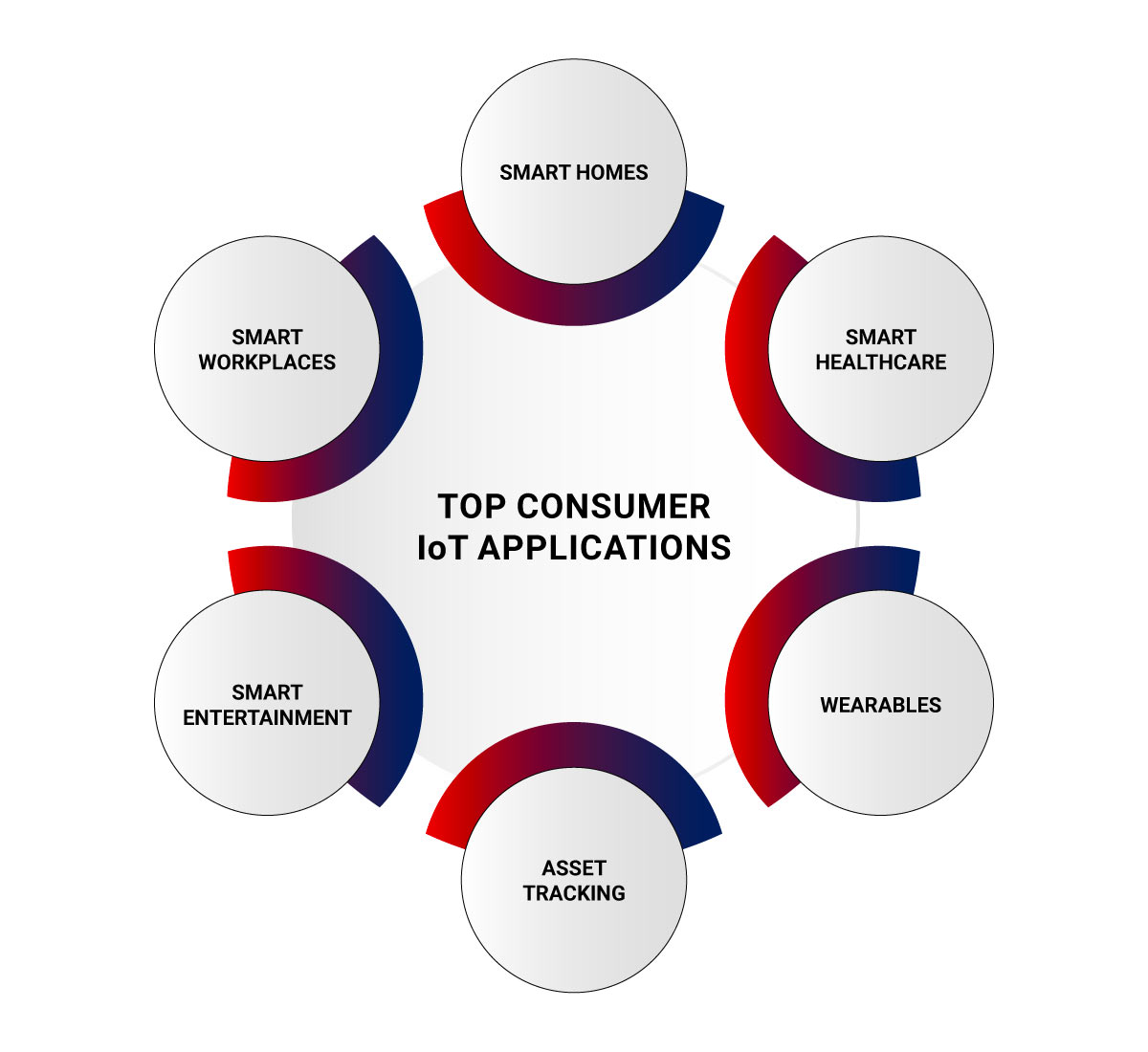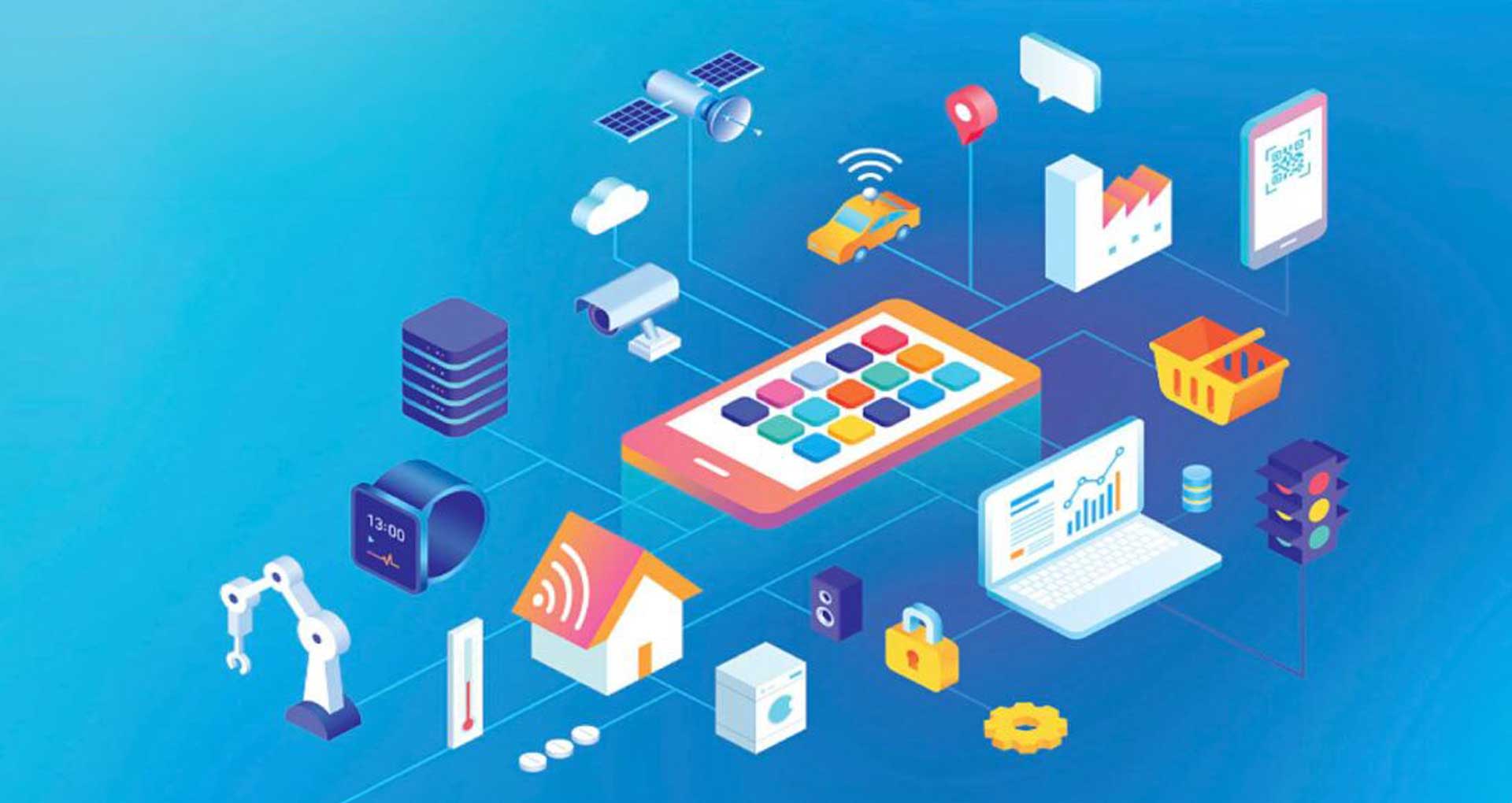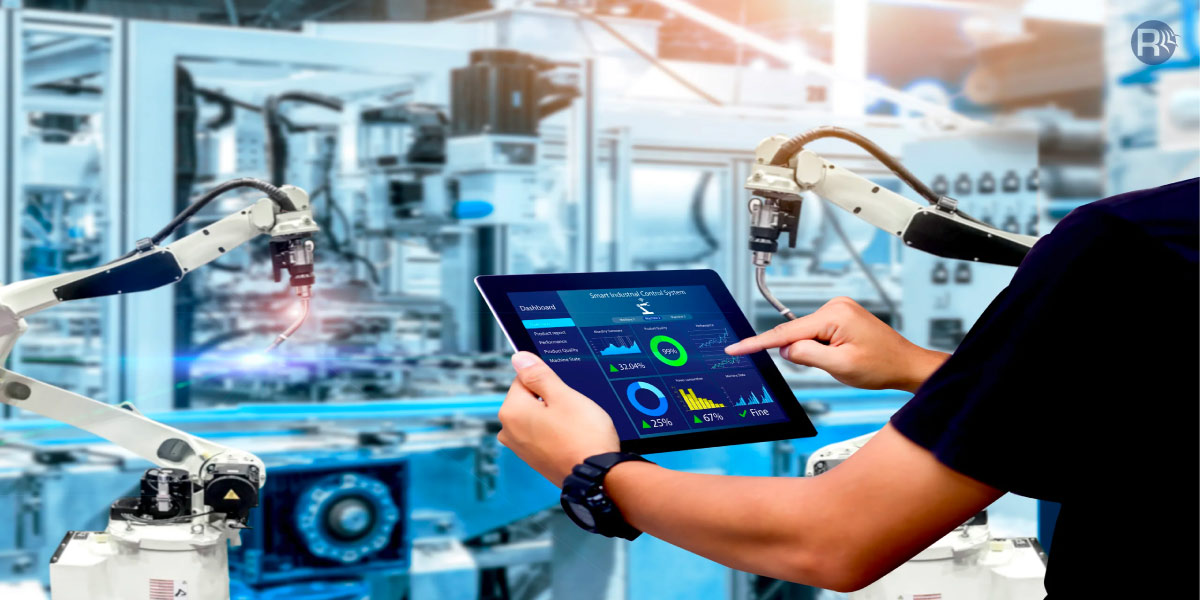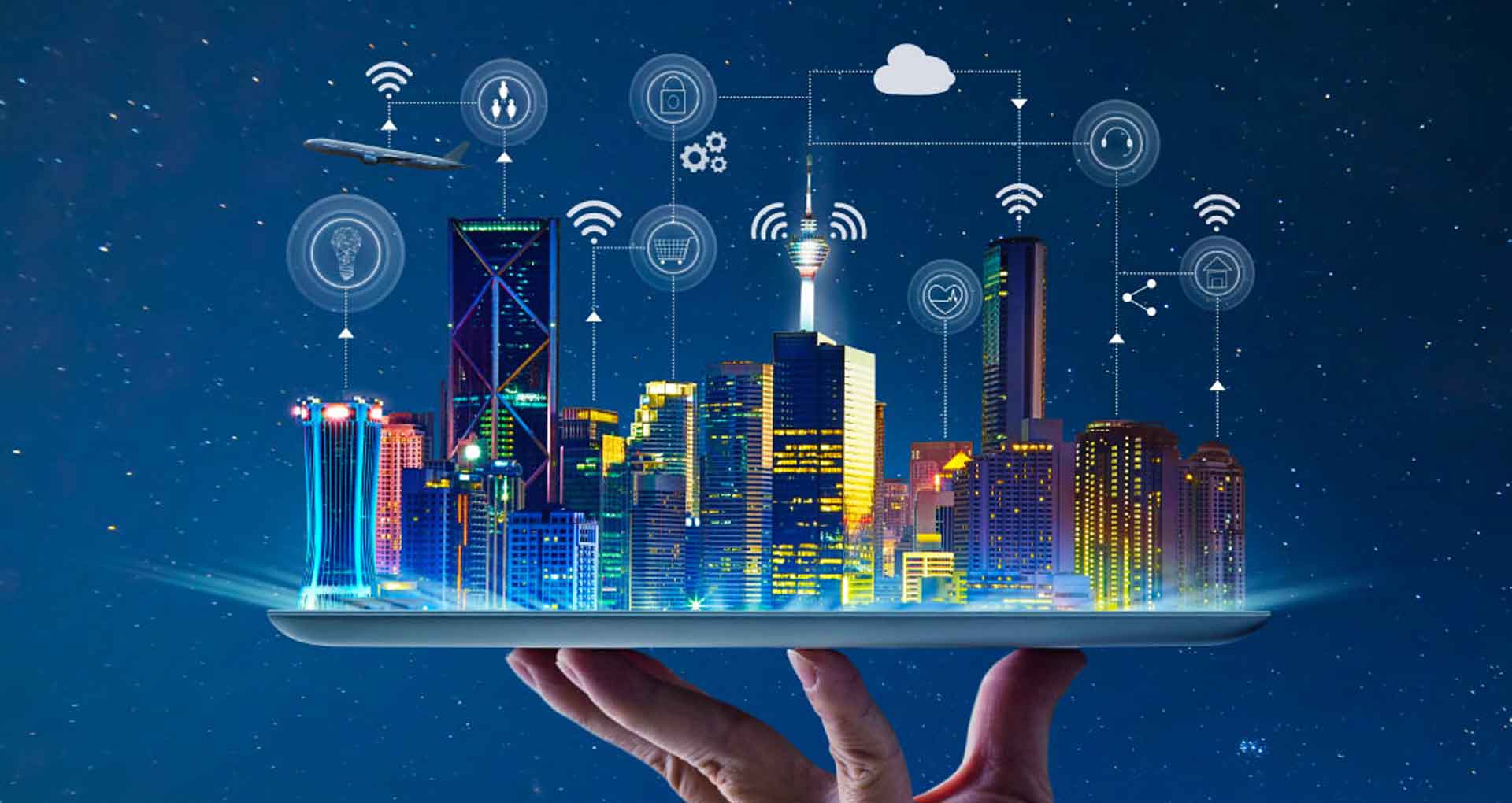The Internet of Things is changing our lives with more and more adoption of consumer electronics. Be it smart televisions, watches, refrigerators, fitness trackers, or intelligent home security systems, smart applications, and technologies have become integral to our daily life. With the adoption of lifestyle changes, there’s huge demand and global acceptance of Consumer IoT applications.
Consumer IoT (CIoT) is an interconnected system of IoT-enabled devices developed for the consumer market. The data that Consumer IoT applications track and exchange with each other allows businesses to personalize customer experiences. With a revenue of nearly US$183.00 billion in 2023, according to Statista[1], the global CIoT industry is a fast growth market and is expected to show an annual growth of 4.83% CAGR from 2023 to 2028.
IoT for consumers can be divided into three segments: Geography, Application (wearables, automotive, healthcare, etc.), and Type (services, hardware, solutions).
This aggressive growth can be credited to the ability of CIoT to reimagine customer experiences, generate value through digitization, unlock better data-driven decisions, and drive better performance and efficiencies.
This blog will explore the concept of consumer IoT, its market analysis, the difference between consumer IoT vs industrial IoT, the types of consumer devices and applications, the top consumer IoT applications, and more.
What is Consumer IoT (CIoT)?
CIoT refers to an IoT-enabled interconnected system of physical and digital objects for the consumer market. Smartphones, smart wearables, and Smart Home automation are popular examples of consumer IoT products. As a subcategory of IoT, CIoT stands out from other types of IoT for its focus on convenience for individual customers. These devices leverage edge computing technologies using embedded sensors and actuators to capture data in real-time. Consumer electronics companies use this data to derive insights to understand consumer habits better. These, in turn, help them deliver personalized consumer experiences at scale.
Consumer IoT Market Analysis and Trends
The global consumer IoT market is expected to grow at a CAGR of 16.69% and reach USD 153.80 billion by 2028 from its valuation of USD 44.46 billion in 2020[2]. Rising disposable incomes, urbanization, and a growing demand for convenience to improve lifestyle have become pivotal in increasing the demand and acceptance of CIoT’s growth. Here are some recent statistics that point to an acceleration in the adoption of CIoT in the next few years:
- The services and wearable devices segments of Consumer IoT are forecasted to grow fastest between 2023 and 2032 at a CAGR of 10.77%[3].
- Wearable consumer IoT devices in healthcare, like the Apple smartwatch, are saving lives by facilitating fall detection and integrating emergency call services.
- The increasing 5G adoption and rising use of smartphones will help the global IoT market reach USD 2,465.26 Billion USD by 2029[4].
- The global smart home market could grow at a CAGR of 21.9% from USD 80.4 billion in 2022 to approximately USD 581.85 billion by 2032[5] due to a rise in the adoption of smart consumer IoT devices in homes.
- The global IoT in the consumer electronics market is projected to increase at a CAGR of 18% and reach around USD 172 Billion by 2030[6].
Difference Between Consumer IoT and Industrial IoT
Even though both consumer and industrial IoT are subcategories of the Internet of Things technology, they have significant differences in terms of implementation. Here’s a table covering the details of Consumer IoT vs Industrial IoT:
| Differences | Consumer IoT | Industrial IoT |
| Focus on Providing | Convenience | Sustainability, Safety |
| Network | Small Scale | Large Scale |
| Installation | Smart homes and Personal devices | Remote and difficult-to-reach areas |
| Impact of Malfunctioning | Local | Widespread |
| Advantages | Automation of personal daily tasks | Optimization of industrial processes |
| Life Span | Short | Long |
| Device | Requires frequent version replacement | Robust quality suitable for extreme conditions |
| Cost | Comparatively less expensive | Comparatively expensive |
Consumer IoT Devices
Consumer IoT permeates our daily routines and offers numerous benefits in myriad settings. Consumer goods manufacturers generally have limited direct contact with customers after the sale. CIoT is fundamentally changing that business model by moving manufacturers closer to the users throughout the product lifecycle. By gathering and processing data from applications on an ongoing basis, organizations can better understand the users’ needs.
Here are the two fundamental types of consumer IoT devices and applications to better understand IoT benefits for consumers. Let’s discuss them with consumer IoT use cases:
Personal IoT
It encompasses a range of devices and applications that enhance convenience and efficiency in individuals’ daily lives. Here are some popular consumer IoT examples of Personal IoT devices:
- Smart Watch: Leading brands like Apple Watch and Fitbit offer wearable devices that track health and provide smart features.
- Hearable: AirPods and Google Pixel Buds are examples of hearable devices that provide wireless audio and smart functionalities.
- Smart Clothing: Smart retail innovations like Ralph Lauren’s smart t-shirt and Arrow Smart Shirt with NFC technology combine fashion with connectivity.
- Smart Glass: Google’s Dropcam and Vuzix Smart Glasses are smart eyewear options with various applications.
- Battery power-sharing between smartphones: Donor Cable bracelets by NAR Mobile enable sharing of battery power between two smartphones.
Smart Home IoT
This consumer IoT device type focuses on automating chores, security, and energy management.
- Security: Nortek Security & Control offers integrated smart home security automation products for access control and emergencies, while Bitdefender BOX provides enhanced IoT home security features.
- Smart Kitchen Gadgets: iGrill Smart grill thermometer, Samsung Family Hub, and Birdi monitors are examples of consumer IoT devices designed to enhance the kitchen experience.
- Lighting Fixtures: Philips Hue Smart Bulbs, LIFX, and L8 SmartLight offer customizable and energy-efficient lighting solutions.
- Family Entertainment: Keep on social robot, Kuri home robot, and Singlecue gesture control devices offer interactive and entertaining experiences.
- Voice Assistance: Google Home Smart Voice-Activated Speaker and Amazon Echo provide voice-controlled smart home capabilities.
- Smart Energy Savings: Ecobee, Ambi Climate, Neurio, iDevices Switch, and Rachio Smart Sprinkler Controller help optimize energy usage.
What Are the Top Consumer IoT Applications?
Advancement in edge computing technologies is driving continuous improvement in the efficiency and scalability of Consumer IoT devices. As a result, CIoT is seeing greater acceptance among consumers and large-scale implementation by businesses. Let’s take a look at a list of the most popular consumer IoT applications:

Smart Homes
The use case of IoT-based smart home automation involves chore automation, safety and security, and energy management. Benefits of IoT to consumers include Smart home IoT solutions that offer security. Convenience, comfort, and enhanced energy efficiency. Apart from home security, you can integrate IoT-connected devices and home appliances to control the temperature, entertainment systems, lighting, and more, all from your smartphone or tablet.
Research expects the number of smart homes to grow and surpass the 400 million[7] mark by 2024. The surge in popularity is due to the rising demand for smart home automation in security and access, entertainment, lighting, HVAC, smart thermostats, sensors, smart kitchens, and other appliances.
Smart Home automation uses a complex architecture that includes a main controller /hub or gateway and sensors connected to remote servers through the internet to secure the property and promptly alert you on detecting any unusual activity.
Apart from home security, you can increase convenience and control in your household by integrating IoT-connected devices and home appliances. So, you can adjust the temperature, control your entertainment systems, manage lighting, and lock your doors, all from your smartphone or tablet. Devices like smart speakers and voice assistants, such as Amazon’s Echo, perform basic tasks. These relatively inexpensive applications have lowered the barrier to IoT deployment in homes. As IoT hubs, these help you easily control several smart home devices using simple voice commands.
Smart Healthcare
CIoT applications in Personal healthcare IoT devices fall into two broad categories: improving health and raising productivity. Popular IoMT devices include a wide range of fitness trackers tracking wellness metrics. They can monitor vital signs, like respiration rate, blood pressure, sleep, pulse rate, blood sugar, body temperature, etc., and provide valuable health data.
Connecting these devices to smartphones and apps helps users gather and track their health information. Consumer IoT solutions allow users to share their healthcare data with medical professionals for timely assistance. They have use cases in various sports and medical fields.
For example, Hexoskin, a smart garment, incorporates textile sensors embedded in comfortable fabrics to measure consumers’ respiratory, cardiac, and critical body activities. Its connected platform collects data and reports insights to healthcare providers to take timely action.
Wearables
Companies are actively developing wearable IoT devices, like smart clothing, watches, hearables, and glasses, to reduce users’ reliance on smartphones. These innovative devices are reshaping the way users engage in daily activities. There is a growing focus on standalone IoT devices that operate independently, eliminating the need for a smartphone to access data.
Wearable devices offer essential safety features, health monitoring capabilities, and daily activity tracking. For instance, wearable IoT technology empowers individuals with disabilities, promoting their independence and overall quality of life. Supervisors in high-risk work environments, like mining or construction, can significantly improve worker safety using network-connected wearable devices like boots, vests, and hard hats. They provide real-time data concerning the workers, which can be analyzed through cloud-based data analytics services, ensuring prompt interventions and proactive safety measures.
Asset Tracking
Consumer IoT simplifies managing personal assets by enabling users to monitor and locate important assets susceptible to loss or theft. For example, Apple’s AirTag, a device that can be securely attached to items like wallets, vehicles, household appliances, etc. It helps users track the precise location of their belongings, facilitating the retrieval of personal items.
IoT-enabled asset tracking goes beyond human belongings and extends to monitoring pets and animals through GPS tracking systems. Companies like PetSafe use low-power devices to connect to the cloud or edge devices. These allow owners to effortlessly keep tabs on pets’ whereabouts, ensuring their safety even if they stray away. You can easily maintain comprehensive coverage over extensive areas by leveraging low-power wide-area networks (LPWAN) like AWS FreeRTOS and establishing reliable IoT connections.
Smart Entertainment
The Internet of Things (IoT) has revolutionized the nightlife scene in many countries, playing a crucial role in attracting tourists and delighting customers. You’ll find that hotels, bars, and restaurants are taking full advantage of IoT-enabled devices to keep track of customer preferences and elevate their offerings. It means better facilities and a stronger brand identity, making your experience even more memorable.
Imagine having an IoT-powered guide by your side, directing you to the hottest spots in the city for a fun-filled evening. It will lead you to your destination and provide fascinating tidbits about each place, adding a touch of excitement to your adventure. IoT makes it easier for you to plan a vacation. It actively analyzes your budget and personal preferences, crafting a tailored list of destinations that perfectly match your desires. It even handles hotel room bookings and secures tickets to popular tourist sites, saving time and sparing you from confusion.
Smart Workplaces
You can utilize consumer IoT products at your workplace to enhance efficiency and save time. It helps you record discussions in a meeting room and send briefs to the concerned people. So, you need not jot down every detail or worry about missed information. It sends you timely notifications so that you never miss anything important.
Why Partner with Rishabh Software to Build Consumer IoT Applications?
As a leading IoT software development company, we have in-depth knowledge and extensive experience in helping startups and enterprises to build smart CIoT solutions. Our IoT development team can help you transform your CIoT idea into an MVP and accelerates go-to-market.
So, irrespective of the type of end-to-end consumer IoT solution you need, be it consumer IoT for smart homes, wearables devices, electronic devices, or need-tailored consumer products, we can help you build a consumer-focused IoT solution.
Concluding Thoughts
Consumer IoT has taken convenience and connectivity in daily life to the next level. With many devices and applications focused on improving lifestyle entering the consumer IoT market, it is all set to grow at an accelerated speed. Furthermore, consumer IoT solutions also allow tracking and analyzing user behavior and ensuring that your end-users continually get personalized and immersive user experiences.
Frequently Asked Questions
Q: What are the top factors driving consumer IoT?
A: The following factors are responsible for the impressive growth of consumer IoT:
- The increasing use of the internet across the globe is leading to a significant rise in IoT users.
- An exponential increase in the adoption of smart home devices.
- Higher demand for the Consumer Internet of Things worldwide is leading to the generation of large data sets.
- The enhanced convenience that CIoT applications offer is driving demand among consumers looking to simplify day-to-day activities both personally and in their homes
- The advances in sensor technology and the communication network infrastructure is driving large-scale adoption of CIoT.
- Rising disposable income in both developed and developing countries due to a rise in income. Thus resulting in better purchasing power.
- The enhanced convenience that CIoT applications offer drives consumers to increasingly realize the need to remotely monitor their homes and assets.
- The focus on well-being, especially health, and fitness, has increased multifold post the Covid-19 pandemic.
- Governments across the globe have introduced stricter security regulations for IoT devices, apps, and systems.
- There’s a significant emphasis on research and development to build better IoT-based solutions across industries.
Q: How are consumer demands pushing IoT developments forward?
A: Consumer demands driving IoT developments include the following:
- Consumers seek convenience in daily tasks and require IoT-based solutions that can automate processes and provide seamless connectivity.
- They want to improve their quality of life and look for smart consumer IoT devices that can provide entertainment options, facilitate health monitoring, remotely connect them with healthcare providers, and much more.
- Customers increasingly demand personalized experiences, so they expect their personal smart products to understand their needs and preferences.
- While an increasing number of people are adopting smart consumer IoT products, privacy is their top priority. So, they demand secure IoT devices and systems.
- They expect personal IoT products to be durable, energy-efficient, and sustainable.
- Consumers want to increase simplicity and demand a single control panel or unified interface to control multiple IoT-based devices and appliances.
Q: Which region leads Consumer IoT Market globally?
A: The North American region is leading the consumer IoT market globally. Various factors drive the increased demand in this region. One significant factor is the rising product demand, especially for fitness-tracking gadgets. The growing health consciousness of many diabetes patients and other chronic diseases contributes to the market’s growth. Moreover, the convenience of using medical devices also plays a role in driving the Consumer IoT market in this region.
Footnotes:
1. https://www.statista.com/outlook/tmo/internet-of-things/consumer-iot/worldwide
2. https://www.verifiedmarketresearch.com/product/consumer-iot-market/
3. https://www.precedenceresearch.com/consumer-iot-market
4. https://www.mordorintelligence.com/industry-reports/consumer-iot-market
5. https://www.precedenceresearch.com/smart-home-market
6. https://www.marketresearchfuture.com/reports/iot-consumer-electronics-market-997
7. https://www.statista.com/topics/2430/smart-homes/#topicOverview










 30 Min
30 Min


